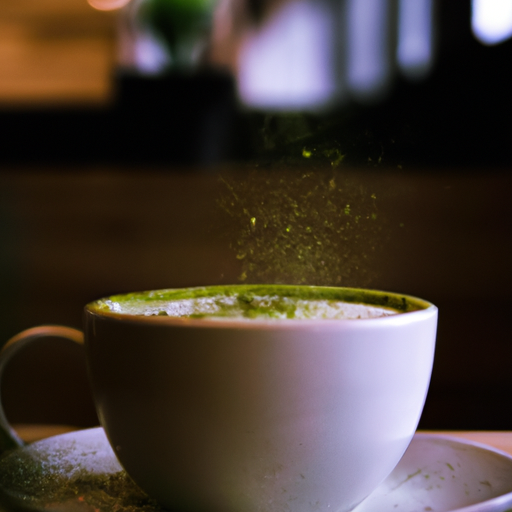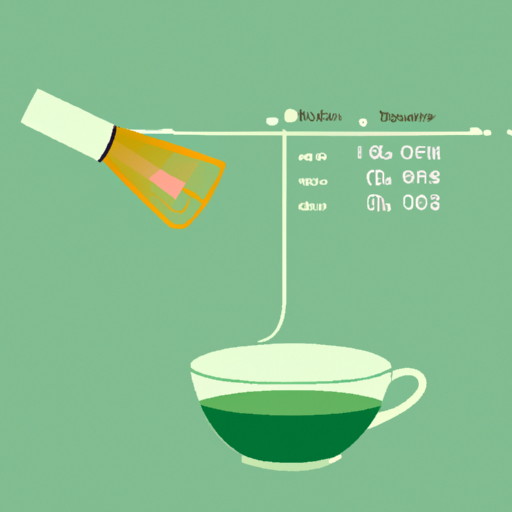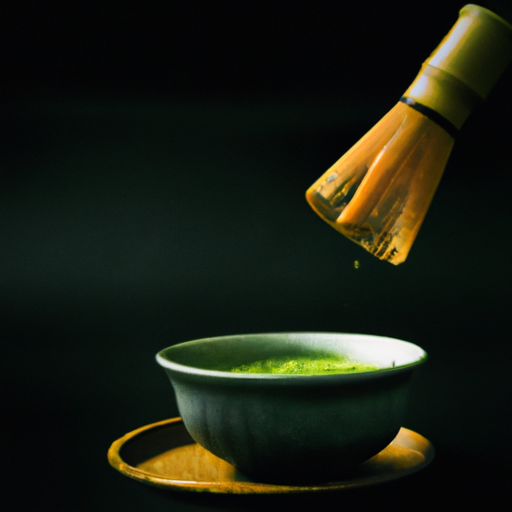As someone who loves both coffee and tea, I’m constantly searching for new and intriguing beverages to sample. Lately, the buzz around matcha lattes has caught my attention, and I just had to give them a try.
But before I took my first sip, I couldn’t help but wonder: what do matcha lattes actually taste like? As someone who’s never tried matcha before, I was intrigued by its vibrant green color and unique flavor profile. I had heard that matcha was a type of green tea that was ground into a fine powder and used in traditional Japanese tea ceremonies. But beyond that, I didn’t know much about it.
So, I decided to do some research and find out more about this trendy drink. In this article, I’ll be exploring the taste and health benefits of matcha, as well as sharing some tips on how to make your own matcha latte at home. Let’s dive in!
Key Takeaways
- Matcha lattes have an umami flavor and are high in antioxidants and catechins, making them more nutritionally beneficial than regular green tea.
- Matcha lattes can be made with a variety of milks and sweeteners, and can be served hot or iced.
- Frothing techniques can affect the taste and texture of the matcha latte.
- Matcha powder can be purchased online for making at home, and matcha can be incorporated into many dishes beyond just lattes.
What is Matcha?
If you’ve never tried matcha before, you might be wondering what all the fuss is about. Matcha is a finely ground green tea powder that has become a popular ingredient in everything from lattes to desserts. It has a vibrant green color and a unique flavor that sets it apart from other teas.
Matcha is grown in several regions of Japan, including Uji, Nishio, and Shizuoka. These regions have the ideal climate and soil conditions for growing high-quality matcha. Matcha has been used in Japanese tea ceremonies for centuries, and it is still a significant part of the country’s cultural heritage.
The tea is prepared using a traditional method that involves whisking the powder with hot water until it forms a frothy, creamy texture. Matcha is also used in cooking, and it can be added to a variety of dishes, including ice cream, smoothies, and baked goods.
When it comes to the flavor profile of matcha, it has a distinct taste that is both earthy and slightly bitter. Some people describe it as having a vegetal, grassy flavor, while others note its nutty undertones. The quality of the matcha can also affect its flavor, with higher-grade matcha being more complex and nuanced.
Overall, matcha has a bold flavor that can take some getting used to, but once you acquire a taste for it, you’ll find it difficult to go back to regular tea.
The Flavor Profile of Matcha
You’ll definitely notice the earthy and slightly bitter notes of matcha when you first take a sip, but the creamy texture of the milk and the subtle sweetness of any added sweeteners can balance out the flavor and create a unique taste experience. Matcha has an umami flavor, which is a savory taste that is often found in Japanese cuisine. It’s an acquired taste, but the more you drink it, the more you’ll appreciate its distinct flavor.
Here are some things to keep in mind when it comes to the taste of matcha:
- The flavor can vary depending on the quality of the matcha powder. Higher quality matcha powder will have a more complex flavor profile, with a sweeter and smoother taste.
- Matcha can be used in a variety of culinary ways, from adding it to smoothies and baked goods, to using it as a seasoning for savory dishes like noodles or rice.
- Some people enjoy the taste of matcha on its own, while others prefer it with added sweeteners like honey or maple syrup.
- The taste of matcha can also be affected by the temperature of the water used to make it. Hot water will bring out more of the bitter notes, while cooler water will mellow out the flavor.
In addition to its unique flavor, matcha also has a variety of health benefits.
Health Benefits of Matcha
Indulging in a matcha latte can offer a range of health benefits for those looking to boost their overall well-being.
Matcha is high in antioxidants, which can help prevent cell damage and reduce the risk of chronic diseases. It also contains catechins, a type of polyphenol that’s been linked to improved brain function and a lower risk of heart disease.
Adding matcha to your diet can help increase your intake of important nutrients, such as vitamin C, potassium, and magnesium. These nutrients are essential for maintaining good health and can help support a healthy immune system, strong bones, and a healthy heart.
Matcha is a versatile ingredient that can be used in a variety of recipes, from matcha smoothies to matcha desserts. In addition to its health benefits, matcha is also a delicious and refreshing beverage. Its rich, earthy flavor and vibrant green color make it a popular choice for those looking for a natural energy boost.
So whether you enjoy it as a latte or as a key ingredient in your favorite recipe, matcha is a great way to add a healthy and delicious twist to your diet.
Now, let’s take a look at the difference between matcha and regular green tea.
The Difference Between Matcha and Regular Green Tea
You may think that matcha and regular green tea are the same, but in fact, they differ in taste, preparation, and nutritional benefits.
Matcha is made from shade-grown tea leaves that are ground into a fine powder, while regular green tea is brewed from whole or sliced tea leaves.
Matcha has a distinct taste that is earthy, slightly sweet, and vegetal, while regular green tea is more astringent and bitter.
Matcha also has more nutritional benefits than regular green tea. Since you’re consuming the entire tea leaf when drinking matcha, you get a higher concentration of antioxidants and other beneficial plant compounds.
Matcha also contains more caffeine than regular green tea, making it a great choice for a morning pick-me-up.
When it comes to comparing matcha to other types of tea, such as black tea or herbal tea, the differences are even more pronounced.
Black tea is fully oxidized and has a bold, robust flavor, while herbal tea is made from various herbs and spices and can have a wide range of flavors and health benefits.
Matcha, on the other hand, has a unique umami flavor and a bright green color that sets it apart from all other types of tea.
If you want to enjoy the unique taste and health benefits of matcha, one way to do so is by making a matcha latte.
How to Make a Matcha Latte
First, let’s gather the necessary ingredients for making a delicious matcha latte at home. You’ll need:
- Matcha powder – make sure to choose a high-quality brand for the best taste
- Milk – any type of milk will work, but many people prefer a frothy, creamy texture from using whole milk or a dairy alternative like oat or almond milk
- Sweetener – optional, but some people like to add a natural sweetener like honey or agave
To make a matcha latte, start by whisking the matcha powder with a small amount of hot water in a bowl until it forms a smooth paste.
Heat your milk on the stovetop or in the microwave until steaming hot, but not boiling.
Froth the milk using a frother or whisk until it becomes creamy and frothy.
Next, pour the matcha paste into a cup, then slowly pour the hot frothed milk over it. If you’re feeling creative, you can use matcha latte art techniques to make a cute design on top of the froth.
Now that you know how to make a basic matcha latte, you can experiment with different variations such as adding vanilla extract or trying different milk alternatives.
But before we get into that, let’s talk more about matcha latte frothing techniques and how they can make a big difference in the taste and texture of your drink.
Variations of Matcha Lattes
I love experimenting with different variations of matcha lattes to find the perfect flavor and sweetness. One way to add more flavor is by adding different sweeteners like honey or agave.
I also love making an iced matcha latte during warmer months or using coconut milk for a creamier texture.
Adding Flavors or Sweeteners
If you’re looking to add some extra flavor to your matcha latte, you could try adding vanilla syrup or honey for a touch of sweetness. For example, Sarah likes to add a drizzle of honey to her matcha latte for a natural sweetener that complements the earthy flavor of the matcha.
Here are four other ways to add flavor to your matcha latte:
- Almond milk – Swap out regular milk for almond milk to add a nutty flavor to your matcha latte.
- Coconut cream – For a tropical twist, add a dollop of coconut cream to your matcha latte.
- Cinnamon – A sprinkle of cinnamon adds warmth and depth to the flavor profile of matcha.
- Chocolate – Add a bit of chocolate syrup or cocoa powder for a decadent treat.
Now, if you’re looking for a refreshing twist on the classic matcha latte, try making an iced matcha latte.
Iced Matcha Latte
Cool off with a refreshing twist on the classic matcha latte by making an iced version that’s perfect for hot summer days.
To make an iced matcha latte, simply mix matcha powder with hot water first, and then pour it over ice. Add your choice of milk and sweetener, and stir well. You can even get creative with your iced matcha latte by incorporating matcha latte art, such as a heart or a leaf, on top of the foam.
Iced matcha latte is a popular drink that’s enjoyed by many matcha lovers around the world. The cold and creamy texture of the milk combined with the earthy and slightly sweet flavor of matcha powder creates a perfect balance of flavors. Plus, it’s a great way to get your daily dose of antioxidants and caffeine in a refreshing and delicious way.
Now, let’s move on to the next section, where we’ll explore how to make a matcha latte with coconut milk.
Matcha Latte with Coconut Milk
Iced matcha lattes are a refreshing way to enjoy the unique taste of matcha. But have you ever tried a matcha latte with coconut milk? The combination of creamy coconut and earthy matcha creates a deliciously smooth and velvety drink that is perfect for any time of the day. As someone who loves the taste of coconut, I was excited to try this alternative milk option and was pleasantly surprised by how well it complemented the matcha flavor.
To make a matcha latte with coconut milk, you can use any coconut milk alternative that you prefer. Whether it’s canned, carton, or homemade, the key is to froth the milk until it’s nice and creamy. This will help create a rich and foamy texture that is perfect for foam art techniques. Once you have your milk frothed, simply mix in some matcha powder and a sweetener of your choice. I personally like to use honey or agave nectar to balance out the bitterness of the matcha.
If you’re looking to switch up your matcha latte routine, I highly recommend trying it with coconut milk. The creamy texture and tropical flavor of the coconut add a fun twist that is sure to impress your taste buds. And if you’re feeling adventurous, try your hand at some foam art techniques to take your latte to the next level. Next, let’s explore where you can find matcha lattes outside of your own kitchen.
Where to Find Matcha Lattes
You can easily find matcha lattes at most coffee shops and cafes nowadays. It’s become a popular alternative to the usual coffee and tea beverages. Here are three places where you can get your matcha latte fix:
-
Starbucks – This coffee chain offers a matcha latte that’s made with finely ground Teavana matcha green tea and steamed milk. You can customize your drink by adding different types of milk, sweeteners, and flavors.
-
Local cafes – Many independent coffee shops and cafes also offer matcha lattes. Some may even have their own unique recipes that use different types of milk or sweeteners.
-
Online retailers – If you prefer to make your own matcha latte at home, there are several online retailers that sell matcha powder. You can experiment with different brands and grades of matcha to find the one that suits your taste.
While matcha lattes are widely available, there are also other alternatives if you want to switch things up. In the next section, we’ll explore some of these options.
Matcha Latte Alternatives
Looking for a change from your usual matcha latte? There are plenty of delicious alternatives to try.
While matcha lattes are undoubtedly a tasty and healthy drink option, sometimes it’s good to switch things up and try something new.
Fortunately, there are a variety of matcha latte alternatives available that offer unique flavors and health benefits.
One popular alternative is a turmeric latte, also known as a golden latte. This bright yellow drink is made with ground turmeric, coconut milk, honey, and spices like cinnamon and ginger. The combination of sweet and spicy flavors makes for a warming and comforting drink that is also anti-inflammatory and immune-boosting.
Another option is a beetroot latte, which is made with beetroot powder, steamed milk, and a touch of honey or maple syrup. This vibrant pink drink is not only beautiful to look at, but it’s also packed with antioxidants and other nutrients that are great for the body. The earthy, slightly sweet flavor of the beetroot pairs perfectly with the creamy milk and sweetener.
If you’re looking to try something different than your usual matcha latte, there are plenty of unique and flavorful alternatives to explore. Whether you opt for a golden latte or a beetroot latte, you’re sure to find a drink that’s both delicious and healthy.
And if you’re feeling adventurous, you can even try experimenting with different flavor combinations and creating your own matcha-inspired drinks. Speaking of which, let’s dive into some matcha recipes!
Matcha Recipes
Indulge in the creamy and delicious matcha latte cheesecake that’ll satisfy your sweet tooth and matcha cravings all at once! This recipe is a perfect alternative to a classic matcha latte and is easy to make at home.
The matcha powder is mixed with cream cheese, sugar, and heavy cream, creating a smooth and velvety texture. The crust is made with crushed graham crackers and melted butter, giving it a crunchy and buttery taste that pairs perfectly with the matcha filling.
If you’re looking for more creative matcha recipes, try making a matcha smoothie bowl for breakfast or a matcha-infused cocktail for happy hour. Matcha smoothie bowls are a healthy and refreshing way to start your day and can be customized with your favorite fruits and toppings. Matcha cocktails are a fun way to switch up your usual drinks and can be made with ingredients like vodka, lime juice, and honey syrup.
Overall, there are many delicious matcha latte alternatives and creative matcha recipes to try at home. Whether you’re looking for a sweet treat or a refreshing drink, matcha is a versatile ingredient that can be incorporated into many different dishes.
So, why not try something new and experiment with matcha in your own kitchen? You may be surprised at how delicious and satisfying these recipes can be!
Frequently Asked Questions
What is the caffeine content in a matcha latte compared to regular coffee?
In terms of caffeine comparison, a matcha latte typically contains less caffeine than a regular coffee.
While a standard 8-ounce cup of coffee contains around 95 milligrams of caffeine, a matcha latte typically contains around 60-80 milligrams of caffeine per serving.
However, it’s worth noting that matcha contains a unique type of caffeine called theophylline, which is believed to provide a more sustained energy boost without the crash often associated with coffee.
Additionally, matcha is also packed with antioxidants and other health benefits, such as reducing inflammation and boosting metabolism.
So, while a matcha latte may not provide the same jolt of caffeine as a regular coffee, it does offer a range of other health benefits worth considering.
Can matcha powder be used in baking recipes?
I know what you may be thinking: matcha powder is only good for making lattes and drinks, not for baking. But let me tell you, matcha powder can actually be a great addition to your baking recipes!
Not only does it add a unique flavor profile to your desserts, but it also provides some health benefits. Matcha powder baking can result in some delicious matcha flavored desserts such as matcha cookies, cakes, and even ice cream.
The subtle bitterness and earthy taste of matcha powder pairs well with sweet flavors, making it a great ingredient for baking. So next time you’re in the kitchen, don’t be afraid to experiment with matcha powder and add some extra flavor and nutrition to your baked goods.
Are there any potential side effects or risks associated with consuming matcha?
When it comes to consuming matcha, there are some potential risks to be aware of. The main concern is the caffeine content, which can cause side effects like jitteriness, insomnia, and rapid heartbeat if consumed in excess. It’s important to stick to recommended dosages and not overdo it on the matcha.
On the flip side, there are also many health benefits associated with matcha consumption. Matcha is packed with antioxidants, which can help protect against chronic diseases and inflammation.
Overall, as long as you consume matcha in moderation and pay attention to how your body reacts, it can be a healthy addition to your diet.
How long does a matcha latte stay fresh after it is prepared?
As the saying goes, time flies when you’re having fun. The same can be said for the shelf life of a matcha latte.
Once prepared, a matcha latte can stay fresh for about 24 hours when stored properly in the fridge. It’s important to use a sealable container to prevent any air or moisture from entering and affecting the taste and quality of the drink.
Additionally, it’s best to consume the latte as soon as possible to fully enjoy the rich and creamy flavor that matcha lattes are known for. Remember, the key to a fresh and delicious matcha latte is proper storage methods and consuming it in a timely manner.
Is there a difference in the quality and taste of matcha from different regions or brands?
When it comes to matcha, the quality and taste can vary greatly depending on the region and brand. Matcha grading is an important factor to consider, as higher grades tend to be smoother and less bitter.
Different regions also have their own unique flavor profiles, which can range from earthy and vegetal to more floral and sweet. Additionally, cultural significance and production methods can play a role in the taste of matcha.
For example, matcha from Japan is often considered the highest quality due to traditional cultivation and processing methods. Ultimately, it’s worth exploring different brands and regions to find the matcha that best suits your taste preferences.
Conclusion
So there you have it, folks! Matcha lattes are not only delicious but also packed with numerous health benefits. As someone who enjoys drinking them regularly, I can attest to their unique flavor profile that is both earthy and sweet.
But did you know that the global matcha market is predicted to reach $2.1 billion by 2024? This staggering statistic shows just how popular matcha has become in recent years and highlights the growing interest in health and wellness.
It’s no surprise that more and more people are opting for matcha lattes as a healthier alternative to sugary drinks. With its numerous health benefits and delicious taste, it’s no wonder matcha lattes have become a staple in many coffee shops and households.
So next time you’re looking for a tasty and nutritious drink, give matcha a try!










